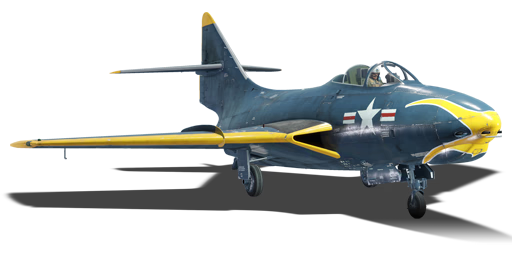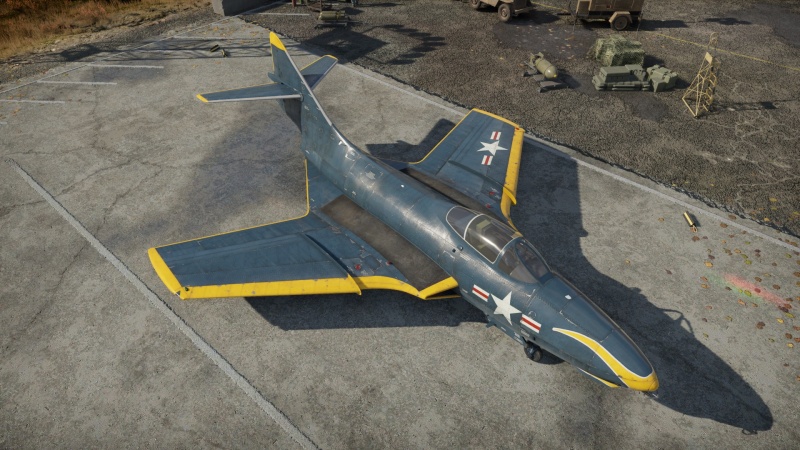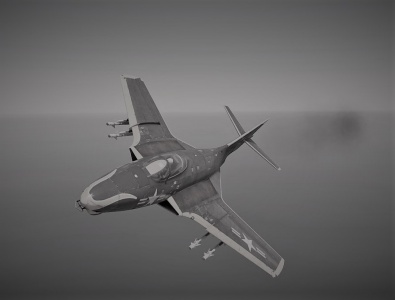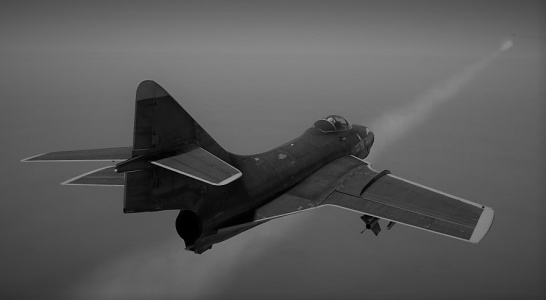Difference between revisions of "F9F-8"
(Updated format) |
|||
| Line 1: | Line 1: | ||
| − | |||
| − | |||
| − | |||
| − | |||
| − | |||
| − | |||
| − | |||
{{About | {{About | ||
| about = American naval jet fighter '''{{PAGENAME}}''' | | about = American naval jet fighter '''{{PAGENAME}}''' | ||
| usage = other uses | | usage = other uses | ||
| link = F9F (Family) | | link = F9F (Family) | ||
| + | }} | ||
| + | {{Specs-Card | ||
| + | |code=f9f-8 | ||
| + | |images={{Specs-Card-Image|GarageImage_{{PAGENAME}}.jpg}} | ||
| + | |cockpit=cockpit_f9f-8.jpg | ||
}} | }} | ||
== Description == | == Description == | ||
<!-- ''In the description, the first part should be about the history of and the creation and combat usage of the aircraft, as well as its key features. In the second part, tell the reader about the aircraft in the game. Insert a screenshot of the vehicle, so that if the novice player does not remember the vehicle by name, he will immediately understand what kind of vehicle the article is talking about.'' --> | <!-- ''In the description, the first part should be about the history of and the creation and combat usage of the aircraft, as well as its key features. In the second part, tell the reader about the aircraft in the game. Insert a screenshot of the vehicle, so that if the novice player does not remember the vehicle by name, he will immediately understand what kind of vehicle the article is talking about.'' --> | ||
| − | |||
| − | |||
The '''{{Specs|name}}''' is a rank {{Specs|rank}} American naval jet fighter {{Battle-rating}}. It was introduced in [[Update 1.63 "Desert Hunters"]]. | The '''{{Specs|name}}''' is a rank {{Specs|rank}} American naval jet fighter {{Battle-rating}}. It was introduced in [[Update 1.63 "Desert Hunters"]]. | ||
| Line 23: | Line 19: | ||
''Describe how the aircraft behaves in the air. Speed, manoeuvrability, acceleration and allowable loads - these are the most important characteristics of the vehicle.'' | ''Describe how the aircraft behaves in the air. Speed, manoeuvrability, acceleration and allowable loads - these are the most important characteristics of the vehicle.'' | ||
| − | {| class="wikitable" style="text-align:center" | + | {| class="wikitable" style="text-align:center" width="70%" |
! rowspan="2" | Characteristics | ! rowspan="2" | Characteristics | ||
! colspan="2" | Max Speed<br>(km/h at 610 m) | ! colspan="2" | Max Speed<br>(km/h at 610 m) | ||
| Line 37: | Line 33: | ||
|- | |- | ||
! Upgraded | ! Upgraded | ||
| − | | | + | | ___ || ___ || __._ || __._ || __._ || __._ |
|- | |- | ||
|} | |} | ||
| − | ====Details==== | + | ==== Details ==== |
| − | {| class="wikitable" style="text-align:center" | + | {| class="wikitable" style="text-align:center" width="50%" |
|- | |- | ||
! colspan="6" | Features | ! colspan="6" | Features | ||
| Line 52: | Line 48: | ||
|} | |} | ||
| − | {| class="wikitable" style="text-align:center" | + | {| class="wikitable" style="text-align:center" width="50%" |
|- | |- | ||
! colspan="7" | Limits | ! colspan="7" | Limits | ||
| Line 114: | Line 110: | ||
=== Survivability and armour === | === Survivability and armour === | ||
{{Specs-Avia-Armour}} | {{Specs-Avia-Armour}} | ||
| − | <!-- Examine the survivability of the aircraft. Note how vulnerable the structure is and how secure the pilot is, whether the fuel tanks are armoured, etc. Describe the armour, if there is any, and also mention the vulnerability of other critical aircraft systems. --> | + | <!-- ''Examine the survivability of the aircraft. Note how vulnerable the structure is and how secure the pilot is, whether the fuel tanks are armoured, etc. Describe the armour, if there is any, and also mention the vulnerability of other critical aircraft systems.'' --> |
* 9.5 mm steel - in front of cockpit | * 9.5 mm steel - in front of cockpit | ||
| Line 120: | Line 116: | ||
* 60 mm steel - armoured windscreen | * 60 mm steel - armoured windscreen | ||
| − | === Modifications and | + | === Modifications and economy === |
{{Specs-Economy}} | {{Specs-Economy}} | ||
| Line 128: | Line 124: | ||
{{Specs-Avia-Offensive}} | {{Specs-Avia-Offensive}} | ||
<!-- ''Describe the offensive armament of the aircraft, if any. Describe how effective the cannons and machine guns are in a battle, and also what belts or drums are better to use. If there is no offensive weaponry, delete this subsection.'' --> | <!-- ''Describe the offensive armament of the aircraft, if any. Describe how effective the cannons and machine guns are in a battle, and also what belts or drums are better to use. If there is no offensive weaponry, delete this subsection.'' --> | ||
| − | {{main| | + | {{main|M3 (20 mm)}} |
The '''''{{PAGENAME}}''''' is armed with: | The '''''{{PAGENAME}}''''' is armed with: | ||
| − | * 4 x | + | * 4 x 20 mm M3 cannons, nose-mounted (190 rpg = 760 total) |
=== Suspended armament === | === Suspended armament === | ||
{{Specs-Avia-Suspended}} | {{Specs-Avia-Suspended}} | ||
<!-- ''Describe the aircraft's suspended armament: additional cannons under the wings, bombs, rockets and torpedoes. This section is especially important for bombers and attackers. If there is no suspended weaponry remove this subsection.'' --> | <!-- ''Describe the aircraft's suspended armament: additional cannons under the wings, bombs, rockets and torpedoes. This section is especially important for bombers and attackers. If there is no suspended weaponry remove this subsection.'' --> | ||
| − | {{main|AN-M64A1 (500 lb)|AN-M65A1 (1,000 lb)|AIM-9B}} | + | {{main|AN-M64A1 (500 lb)|AN-M65A1 Fin M129 (1,000 lb)|AIM-9B Sidewinder}} |
The '''''{{PAGENAME}}''''' can be outfitted with the following ordnance: | The '''''{{PAGENAME}}''''' can be outfitted with the following ordnance: | ||
* Without load | * Without load | ||
| − | * 4 | + | * 4 x 500 lb AN-M64A1 bombs (2,000 lb total) |
| − | * 2 | + | * 2 x 1,000 lb AN-M65A1 Fin M129 bombs (2,000 lb total) |
| − | * 4 | + | * 4 x AIM-9B Sidewinder missiles |
== Usage in battles == | == Usage in battles == | ||
| − | <!-- Describe the tactics of playing in | + | <!-- ''Describe the tactics of playing in the aircraft, the features of using aircraft in a team and advice on tactics. Refrain from creating a "guide" - do not impose a single point of view, but instead, give the reader food for thought. Examine the most dangerous enemies and give recommendations on fighting them. If necessary, note the specifics of the game in different modes (AB, RB, SB).'' --> |
First of your objective when you purchase this plane is to research as fast as you can the 20 mm cannons modifications. The F9F-8 default cannons get jammed in a quick burst. | First of your objective when you purchase this plane is to research as fast as you can the 20 mm cannons modifications. The F9F-8 default cannons get jammed in a quick burst. | ||
| − | This said | + | This said don't expect to dogfight very well against any pure fighter jet as the turn time is quite stock but when you spade it out turning does get a better but the F9F-8 performs great defensive manoeuvres and can keep up in turns with the MiGs (beware that doesn't have the great acceleration that MiGs have). |
This is not an air superiority aircraft, its main purpose is to support ground vehicles and planes. | This is not an air superiority aircraft, its main purpose is to support ground vehicles and planes. | ||
| − | The best tactics if you are new to this plane is to fly it like | + | The best tactics if you are new to this plane is to fly it like a F9F-2 or F9F-5 so stay near some allies and give them support. |
* Never roll too hard over 750 km\h (466 mph) or the wings will explode | * Never roll too hard over 750 km\h (466 mph) or the wings will explode | ||
| − | * Never execute | + | * Never execute manoeuvres over –2 G or the wings will explode |
| − | |||
| − | |||
| − | |||
| − | |||
| − | |||
| − | |||
| − | |||
| − | |||
| − | |||
| − | |||
| − | |||
| − | |||
| − | |||
| − | |||
| − | |||
| − | |||
| − | |||
| − | |||
| − | |||
| − | |||
| − | |||
| − | |||
| − | |||
| − | |||
| − | |||
| − | |||
| − | |||
| − | |||
| − | |||
| − | |||
| − | |||
| − | |||
| − | |||
| − | |||
| − | |||
| − | |||
| − | |||
| − | |||
| − | |||
| − | |||
| − | |||
| − | |||
| − | |||
| − | |||
| − | |||
| − | |||
| − | |||
| − | |||
=== Pros and cons === | === Pros and cons === | ||
| − | <!-- '' | + | <!-- ''Summarise and briefly evaluate the vehicle in terms of its characteristics and combat effectiveness. Mark its pros and cons in the bulleted list. Try not to use more than 6 points for each of the characteristics. Avoid using categorical definitions such as "bad", "good" and the like - use substitutions with softer forms such as "inadequate" and "effective".'' --> |
'''Pros:''' | '''Pros:''' | ||
| Line 222: | Line 170: | ||
* Bad aerial performance in turn time, G-limits, acceleration, and energy retention | * Bad aerial performance in turn time, G-limits, acceleration, and energy retention | ||
| − | * Around 800 km/h (500 mph) and above the plane starts to compress quite badly | + | * Around 800 km/h (500 mph) and above the plane starts to compress quite badly |
* Guns tend to jam quickly without New 20 mm upgrade | * Guns tend to jam quickly without New 20 mm upgrade | ||
* Can't equip rockets | * Can't equip rockets | ||
| Line 232: | Line 180: | ||
== History == | == History == | ||
| − | <!--''Describe the history of the creation and combat usage of the aircraft in more detail than in the introduction. If the historical reference turns out to be too | + | <!-- ''Describe the history of the creation and combat usage of the aircraft in more detail than in the introduction. If the historical reference turns out to be too long, take it to a separate article, taking a link to the article about the vehicle and adding a block "/History" (example: <nowiki>https://wiki.warthunder.com/(Vehicle-name)/History</nowiki>) and add a link to it here using the <code>main</code> template. Be sure to reference text and sources by using <code><nowiki><ref></ref></nowiki></code>, as well as adding them at the end of the article with <code><nowiki><references /></nowiki></code>. This section may also include the vehicle's dev blog entry (if applicable) and the in-game encyclopedia description (under <code><nowiki>=== In-game description ===</nowiki></code>, also if applicable).'' --> |
| − | It was Grumman's engineers who first thought of developing their successful F9F Panther fighter into a swept-wing variant. The resulting ''Cougar'' was a very new design in many ways bucking post-war design trends. The fuselage, fin and rudder remained the same, however, the wings were completely new with a 35-degree sweep and lacking the distinctive wingtip tanks of the Panther. The engine was also an upgrade, a Pratt and Whitney J48 with an extra 1,000 kg of thrust over the previous J42. First flight was 20 September 1951, with operational trials starting three months later. Squadron deliveries began in November 1952. 706 F9F-6s with the original engine were produced, and 168 of the F9F-7 which used the Allison J33 turbojet instead. | + | It was Grumman's engineers who first thought of developing their successful F9F Panther fighter into a swept-wing variant. The resulting ''Cougar'' was a very new design in many ways bucking post-war design trends. The fuselage, fin and rudder remained the same, however, the wings were completely new with a 35-degree sweep and lacking the distinctive wingtip tanks of the Panther. The engine was also an upgrade, a Pratt and Whitney J48 with an extra 1,000 kg of thrust over the previous J42. First flight was 20 September 1951, with operational trials starting three months later. Squadron deliveries began in November 1952. 706 F9F-6s with the original engine were produced, and 168 of the F9F-7 which used the Allison J33 turbojet instead. |
| − | The F9F-8 was the final version. Its prototype's first flight was December 1953. In this model, the fuselage was lengthened 30 cm to increase the space for fuel tanks. It had the J48-P-8 engines installed that gave it a total of 3,447kg of Thrust, the wings were also modified slightly to add an in-air refuelling probe plus the capability of mounting four Aim-9 sidewinders and a nose radar was fitted. In total, 601 F9F-8s were built. | + | The F9F-8 was the final version. Its prototype's first flight was December 1953. In this model, the fuselage was lengthened 30 cm to increase the space for fuel tanks. It had the J48-P-8 engines installed that gave it a total of 3,447kg of Thrust, the wings were also modified slightly to add an in-air refuelling probe plus the capability of mounting four Aim-9 sidewinders and a nose radar was fitted. In total, 601 F9F-8s were built. |
| − | The F9F-8 was too late to see combat in Korea, however, there were four trainer versions of the F9F-8 (F9F-8T) deployed to Vietnam and was used in airstrike directing for incoming allied aircraft. | + | The F9F-8 was too late to see combat in Korea, however, there were four trainer versions of the F9F-8 (F9F-8T) deployed to Vietnam and was used in airstrike directing for incoming allied aircraft. |
| − | The Argentine Navy was the only other nation to operate the F9F-8 and was the first jet aircraft that they ever had capable of breaking the sound barrier (In a dive). | + | The Argentine Navy was the only other nation to operate the F9F-8 and was the first jet aircraft that they ever had capable of breaking the sound barrier (In a dive). |
| − | It is also worth noting that the F9F-8 was redesignated, as part of the United States Tri-Service Designation System, to the F-9J in 1962. | + | It is also worth noting that the F9F-8 was redesignated, as part of the United States Tri-Service Designation System, to the F-9J in 1962. |
== Media == | == Media == | ||
| − | <gallery> | + | <!-- ''Excellent additions to the article would be video guides, screenshots from the game, and photos.'' --> |
| + | ;Images | ||
| + | <gallery mode="packed" heights="200"> | ||
F9F-8 left-hand banking turn (In-Game).jpg | F9F-8 left-hand banking turn (In-Game).jpg | ||
F9F-8 Sidewinder.jpg | F9F-8 Sidewinder.jpg | ||
</gallery> | </gallery> | ||
| + | ;Skins | ||
{{Skin-gallery | {{Skin-gallery | ||
|market|ugcitem_1000237|F9F-8 Lynx.png|Camo "Lynx" | |market|ugcitem_1000237|F9F-8 Lynx.png|Camo "Lynx" | ||
}} | }} | ||
| + | ;Videos | ||
{{Youtube-gallery | {{Youtube-gallery | ||
|iQ97c_m8G0I|'''The Shooting Range #16''' - ''Pages of History'' section at 04:05 discusses the F9F-8. | |iQ97c_m8G0I|'''The Shooting Range #16''' - ''Pages of History'' section at 04:05 discusses the F9F-8. | ||
| Line 259: | Line 211: | ||
== See also == | == See also == | ||
| − | <!--''Links to the articles on the War Thunder Wiki that you think will be useful for the reader, for example:'' | + | <!-- ''Links to the articles on the War Thunder Wiki that you think will be useful for the reader, for example:'' |
| − | * ''reference to the series of the | + | * ''reference to the series of the aircraft;'' |
| − | * ''links to approximate analogues of other nations and research trees.''--> | + | * ''links to approximate analogues of other nations and research trees.'' --> |
* [[F9F-2]] | * [[F9F-2]] | ||
| Line 272: | Line 224: | ||
* ''other literature.'' --> | * ''other literature.'' --> | ||
| − | * [ | + | * [[wt:en/news/4239-development-f9f-8-cougar-a-perfect-predator-en/|[Devblog] F9F-8 Cougar - A Perfect Predator]] |
{{AirManufacturer Grumman}} | {{AirManufacturer Grumman}} | ||
{{USA jet aircraft}} | {{USA jet aircraft}} | ||
Revision as of 18:23, 25 December 2020
| This page is about the American naval jet fighter F9F-8. For other uses, see F9F (Family). |
Contents
Description
The F9F-8 Cougar is a rank American naval jet fighter with a battle rating of (AB), (RB), and (SB). It was introduced in Update 1.63 "Desert Hunters".
General info
Flight performance
Describe how the aircraft behaves in the air. Speed, manoeuvrability, acceleration and allowable loads - these are the most important characteristics of the vehicle.
| Characteristics | Max Speed (km/h at 610 m) |
Max altitude (metres) |
Turn time (seconds) |
Rate of climb (metres/second) |
Take-off run (metres) | |||
|---|---|---|---|---|---|---|---|---|
| AB | RB | AB | RB | AB | RB | |||
| Stock | 1,019 | 988 | 33.7 | 34.3 | 22.1 | 20.6 | 500 | |
| Upgraded | ___ | ___ | __._ | __._ | __._ | __._ | ||
Details
| Features | |||||
|---|---|---|---|---|---|
| Combat flaps | Take-off flaps | Landing flaps | Air brakes | Arrestor gear | Drogue chute |
| X | X | ✓ | ✓ | ✓ | X |
| Limits | ||||||
|---|---|---|---|---|---|---|
| Wings (km/h) | Gear (km/h) | Flaps (km/h) | Max Static G | |||
| Combat | Take-off | Landing | + | - | ||
| N/A | N/A | 410 | ~9 | ~5 | ||
| Optimal velocities (km/h) | |||
|---|---|---|---|
| Ailerons | Rudder | Elevators | Radiator |
| < 950 | < 790 | < 510 | N/A |
Engine performance
| Engine | Aircraft mass | |||||||
|---|---|---|---|---|---|---|---|---|
| Engine name | Number | Empty mass | Wing loading (full fuel) | |||||
| Pratt & Whitney J48-P-8A | 1 | 5,900 kg | 286 kg/m2 | |||||
| Engine characteristics | Mass with fuel (no weapons load) | Max Takeoff Weight | ||||||
| Weight (each) | Type | 17m fuel | 20m fuel | 30m fuel | 45m fuel | 58m fuel | ||
| 600 kg | Axial-flow turbojet | 6,796 kg | 6,952 kg | 7,472 kg | 8,253 kg | 8,929 kg | 9,636 kg | |
| Maximum engine thrust @ 0 m (RB / SB) | Thrust to weight ratio @ 0 m (100%) | |||||||
| Condition | 100% | WEP | 17m fuel | 20m fuel | 30m fuel | 45m fuel | 58m fuel | MTOW |
| Stationary | 3,182 kgf | N/A | 0.47 | 0.46 | 0.43 | 0.39 | 0.36 | 0.33 |
| Optimal | 3,182 kgf (0 km/h) |
N/A | 0.47 | 0.46 | 0.43 | 0.39 | 0.36 | 0.33 |
Survivability and armour
- 9.5 mm steel - in front of cockpit
- 8.5 mm steel - behind pilot
- 60 mm steel - armoured windscreen
Modifications and economy
Armaments
Offensive armament
The F9F-8 is armed with:
- 4 x 20 mm M3 cannons, nose-mounted (190 rpg = 760 total)
Suspended armament
The F9F-8 can be outfitted with the following ordnance:
- Without load
- 4 x 500 lb AN-M64A1 bombs (2,000 lb total)
- 2 x 1,000 lb AN-M65A1 Fin M129 bombs (2,000 lb total)
- 4 x AIM-9B Sidewinder missiles
Usage in battles
First of your objective when you purchase this plane is to research as fast as you can the 20 mm cannons modifications. The F9F-8 default cannons get jammed in a quick burst.
This said don't expect to dogfight very well against any pure fighter jet as the turn time is quite stock but when you spade it out turning does get a better but the F9F-8 performs great defensive manoeuvres and can keep up in turns with the MiGs (beware that doesn't have the great acceleration that MiGs have).
This is not an air superiority aircraft, its main purpose is to support ground vehicles and planes.
The best tactics if you are new to this plane is to fly it like a F9F-2 or F9F-5 so stay near some allies and give them support.
- Never roll too hard over 750 km\h (466 mph) or the wings will explode
- Never execute manoeuvres over –2 G or the wings will explode
Pros and cons
Pros:
- Good payload options for bombs
- Four 20 mm cannons can shred enemy aircraft and light ground targets
- Slightly better top speed than on the F9F Panther
- Can equip with AIM-9 Sidewinder guided missiles
- Good roll rate over 800 km/h (500 mph)
Cons:
- Bad aerial performance in turn time, G-limits, acceleration, and energy retention
- Around 800 km/h (500 mph) and above the plane starts to compress quite badly
- Guns tend to jam quickly without New 20 mm upgrade
- Can't equip rockets
- When equipped the AIM-9 Sidewinder guided missiles the performance drops dramatically
- Not a good dogfighter among its peers
- Difficult stock grind due to aforementioned poor aerial and firepower performance
- Relatively expensive plane to purchase and train crew with, along with expensive modification costs
- Can be uptiered to encounter jets such as MiG-17s/Shenyang F-5s
History
It was Grumman's engineers who first thought of developing their successful F9F Panther fighter into a swept-wing variant. The resulting Cougar was a very new design in many ways bucking post-war design trends. The fuselage, fin and rudder remained the same, however, the wings were completely new with a 35-degree sweep and lacking the distinctive wingtip tanks of the Panther. The engine was also an upgrade, a Pratt and Whitney J48 with an extra 1,000 kg of thrust over the previous J42. First flight was 20 September 1951, with operational trials starting three months later. Squadron deliveries began in November 1952. 706 F9F-6s with the original engine were produced, and 168 of the F9F-7 which used the Allison J33 turbojet instead.
The F9F-8 was the final version. Its prototype's first flight was December 1953. In this model, the fuselage was lengthened 30 cm to increase the space for fuel tanks. It had the J48-P-8 engines installed that gave it a total of 3,447kg of Thrust, the wings were also modified slightly to add an in-air refuelling probe plus the capability of mounting four Aim-9 sidewinders and a nose radar was fitted. In total, 601 F9F-8s were built.
The F9F-8 was too late to see combat in Korea, however, there were four trainer versions of the F9F-8 (F9F-8T) deployed to Vietnam and was used in airstrike directing for incoming allied aircraft.
The Argentine Navy was the only other nation to operate the F9F-8 and was the first jet aircraft that they ever had capable of breaking the sound barrier (In a dive).
It is also worth noting that the F9F-8 was redesignated, as part of the United States Tri-Service Designation System, to the F-9J in 1962.
Media
- Images
- Skins
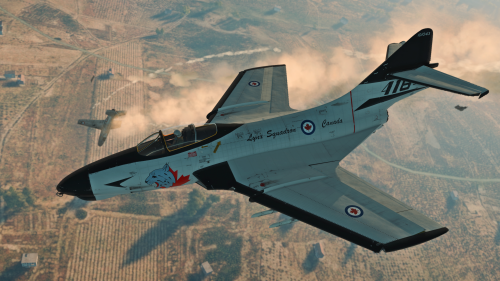
- Videos
See also
External links
| Grumman Aircraft Engineering Corporation | |
|---|---|
| Aircraft | |
| Fighters | |
| F3F | F3F-2 · Galer's F3F-2 |
| F4F Wildcat | F4F-3 · F4F-4 |
| XF5F Skyrocket | XF5F · XP-50 |
| F6F Hellcat | F6F-5 · F6F-5N |
| F7F Tigercat | F7F-1 · F7F-3 |
| F8F Bearcat | F8F-1 · F8F-1B |
| Jet Fighters | |
| F9F Panther/Cougar | F9F-2 · F9F-5 · F9F-8 |
| F-11 Tiger | F11F-1 |
| F-14 Tomcat | F-14A Early · F-14B |
| Jet Strike Aircraft | |
| A-6 Intruder | A-6E TRAM |
| Bombers | TBF-1C |
| Export | ▄Martlet Mk IV · ▄F6F-5 · ▄F6F-5N · ▄F8F-1B · ▄Avenger Mk II · ▄Hellcat Mk II |
| ▄F-14A IRIAF | |
| Naval Vehicles | |
| Patrol Gunboat Hydrofoil (PGH) | USS Flagstaff |
| USA jet aircraft | |
|---|---|
| Fighters | |
| F9F | F9F-2 · F9F-5 · F9F-8 |
| F-80 | F-80A-5 · F-80C-10 |
| F-84 | F-84B-26 · F-84F · F-84G-21-RE |
| F-86 | F-86A-5 · F-86F-25 · F-86F-2 · F-86F-35 |
| F-89 | F-89B · F-89D |
| F-100 | F-100D |
| F-104 | F-104A · F-104C |
| F-4 | F-4C Phantom II · F-4E Phantom II · F-4J Phantom II · F-4S Phantom II |
| F-5 | F-5A · F-5C · F-5E · F-20A |
| F-8 | F8U-2 · F-8E |
| F-14 | F-14A Early · ▄F-14A IRIAF · F-14B |
| F-15 | F-15A · F-15C MSIP II · F-15E |
| F-16 | F-16A · F-16A ADF · F-16C |
| Other | P-59A · F2H-2 · F3D-1 · F3H-2 · F4D-1 · F11F-1 |
| Strike Aircraft | |
| FJ-4 | FJ-4B · FJ-4B VMF-232 |
| A-4 | A-4B · A-4E Early |
| A-7 | A-7D · A-7E · A-7K |
| AV-8 | AV-8A · AV-8C · AV-8B Plus · AV-8B (NA) |
| A-10 | A-10A · A-10A Late · A-10C |
| F-111 | F-111A · F-111F |
| Other | A-6E TRAM · F-105D · F-117 |
| Bombers | |
| B-57 | B-57A · B-57B |


